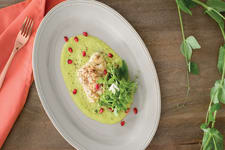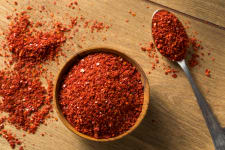Thawing frozen shrimp is simple to do. But doing it right can make a big difference in the taste and texture of your dish. These tried-and-true methods will ensure that shrimp retains its peak quality and that you’re defrosting frozen shrimp safely.
How to Thaw Frozen Shrimp Fast
If you’re short on time and you need to thaw shrimp quickly, the cold water method is the ideal option. This method is a great way to go for those last-minute meal plans because it can thaw shrimp in 15 to 30 minutes, depending on the size and quantity. Large or jumbo shrimp, will need more time to defrost than smaller shrimp.
-
Remove desired portion of frozen shrimp from its packaging.
-
Place your frozen shrimp in a leak-proof bag.
-
Submerge the bag in a large bowl of cold water. You can weigh it down with a clean saucer, plate, or lid to keep the bag of shrimp submerged.
-
Check on the shrimp after 30 minutes. If still not completely defrosted, change out the water with fresh, cool water and allow to thaw for 15 minutes before checking again.
-
Make sure to pat the shrimp dry before cooking to soak up any excess moisture.
How to Defrost Frozen Shrimp Overnight
Thawing shrimp overnight in the refrigerator is a convenient, hands-off way to defrost shrimp. This method takes anywhere between 8 and 12 hours depending on the size of shrimp and how it was frozen, but it keeps the shrimp at a safe temperature and preserves its frozen-at-sea freshness. It’s the best approach if you aren’t in a rush.
-
First, take out the amount of shrimp you plan on using from its original packaging. Arrange the shrimp in a dish in a single layer.
-
Alternatively, you can put the frozen shrimp into a colander which is then set into a larger bowl. As the shrimp defrosts, the excess moisture will drip into the outer bowl. This will prevent the shrimp from sitting in the melt-off and becoming oversaturated.
-
If desired, you can cover the shrimp. Otherwise, it’s perfectly safe to leave the shrimp uncovered as they thaw.
Tips for Properly Thawing Frozen Shrimp
To help your shrimp remain succulent and tasty, consider the tips below.
-
Thaw in cold water or in a cold refrigerator. Always thaw shrimp in a way that prevents it from cooking or getting warm during the process. Using cold water or a refrigerator helps avoid bacteria growth and any unintended cooking.
-
Pat the shrimp dry after thawing to remove excess moisture, which can affect the shrimp's texture when cooked. This will also help achieve a good sear if you plan to sauté or grill the shrimp.
-
When thawing shrimp in the refrigerator, place it in a rimmed plate, bowl, sealed container or a zip-lock bag to prevent any potential cross-contamination with other foods.
-
Once shrimp has been thawed, avoid refreezing it. Refreezing can negatively affect the texture and flavor, making the shrimp less enjoyable to eat.
-
When using the cold water method, resist the urge to use warm water to speed up the process. Warm water can cause the shrimp to thaw unevenly and start cooking, leading to a rubbery texture. It’s also not recommended for food safety.
-
After thawing, inspect the shrimp for any off smells or unusual texture. Fresh shrimp should have a mild, ocean-like scent and firm texture. Discard any shrimp that doesn't meet these standards.
-
If you have a large amount of shrimp, consider separating it into smaller portions before thawing. That way that all pieces thaw evenly and reduces the risk of any shrimp remaining partially frozen.
-
Did you buy frozen shrimp that you plan to thaw later? Keep it in the freezer until you're ready to start the thawing process. Interrupting the cold chain can lead to partial thawing and refreezing, which affects quality.
How to Never Thaw Shrimp
Understanding what not to do is just as important as knowing the best methods. Avoid food safety and quality issues by following these tips.
-
Never leave shrimp to thaw on the counter at room temperature or in hot water. Such methods can lead to bacterial growth and foodborne illnesses. Always use the refrigerator or cold water methods to ensure your shrimp remains safe to eat.
-
Don’t thaw shell-less shrimp under running water (hot or cold), as it can cause it to get mushy and disintegrate.
-
Avoid using a microwave to thaw shrimp, as it can start to cook the shrimp unevenly, leading to a rubbery texture.
How Soon to Use Thawed Shrimp
Once your shrimp is properly thawed, it's important to handle it with care to maintain its quality. If you notice any remaining ice crystals, give the shrimp a quick rinse under cold water, then pat dry.
For the best flavor and texture, if your shrimp was defrosted in the refrigerator, plan to cook it within 24 hours. If defrosted in cold water, it must be cooked immediately. This is the same recommendation when thawing scallops, crab, or any variety of seafood.
Frequently Asked Questions
How Long Can Thawed Shrimp Stay in the Fridge?
If you’ve defrosted shrimp in the refrigerator, it can safely stay in the fridge for up to 1-2 days. It's best to use them within this timeframe to ensure optimal freshness and quality. If you don't use them within this period, you can refreeze the shrimp. But be aware refreezing will affect their texture.
If you defrosted fish on the countertop, you should not move it to the refrigerator. You must cook it immediately for food safety.
Is It Okay to Thaw Frozen Shrimp in Cold Water?
Yes, it is perfectly safe to thaw frozen shrimp in cold water. This is the recommended quick method! To do this, place the shrimp in a resealable plastic bag to prevent contamination. Then submerge the bag in a bowl of cold water. Make sure to change the water every 30 minutes to keep it cold. Depending on the size, the shrimp should thaw in about 15-60 minutes.
You must cook shrimp immediately when thawed this way.
Can I Leave Frozen Shrimp on the Counter to Thaw?
No, you should never thaw frozen shrimp on the counter (unless it’s in a bowl of cold water). Thawing at room temperature can cause the shrimp to enter the "danger zone" (40°F to 140°F). Here bacteria can grow rapidly, increasing the risk of foodborne illness. Always use safe methods like thawing in the refrigerator or in cold water to ensure food safety.






